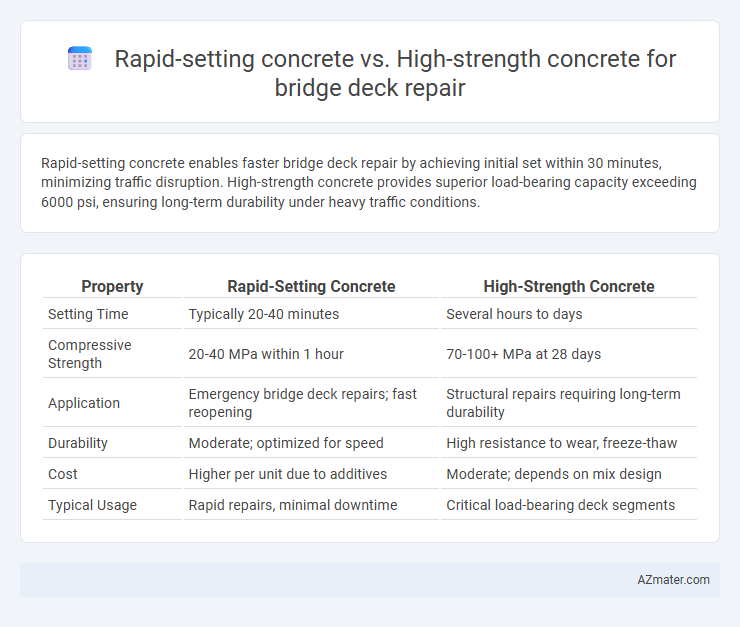Rapid-setting concrete enables faster bridge deck repair by achieving initial set within 30 minutes, minimizing traffic disruption. High-strength concrete provides superior load-bearing capacity exceeding 6000 psi, ensuring long-term durability under heavy traffic conditions.
Table of Comparison
| Property | Rapid-Setting Concrete | High-Strength Concrete |
|---|---|---|
| Setting Time | Typically 20-40 minutes | Several hours to days |
| Compressive Strength | 20-40 MPa within 1 hour | 70-100+ MPa at 28 days |
| Application | Emergency bridge deck repairs; fast reopening | Structural repairs requiring long-term durability |
| Durability | Moderate; optimized for speed | High resistance to wear, freeze-thaw |
| Cost | Higher per unit due to additives | Moderate; depends on mix design |
| Typical Usage | Rapid repairs, minimal downtime | Critical load-bearing deck segments |
Introduction to Bridge Deck Repair Materials
Rapid-setting concrete enables quick bridge deck repairs due to its accelerated curing time, minimizing traffic disruption and allowing for faster project turnovers. High-strength concrete offers superior load-bearing capacity and durability, essential for long-term performance under heavy traffic and environmental stresses. Selecting the appropriate material depends on balancing repair speed requirements with structural demands for longevity and resilience.
Overview of Rapid-setting Concrete
Rapid-setting concrete offers accelerated curing times, achieving initial strength within hours, making it ideal for minimizing traffic disruptions during bridge deck repairs. Its composition typically includes cementitious materials with admixtures like calcium chloride to enhance early strength development and durability under heavy loads. This concrete type provides reliable performance in cold weather conditions and is engineered to resist shrinkage and cracking, ensuring long-term resilience in infrastructure applications.
Overview of High-strength Concrete
High-strength concrete (HSC) for bridge deck repair is characterized by a compressive strength typically exceeding 6,000 psi (41 MPa), providing superior durability and load-bearing capacity compared to conventional concrete. This type of concrete incorporates low water-to-cement ratios and advanced admixtures to enhance mechanical properties, reduce permeability, and improve resistance to environmental stressors such as freeze-thaw cycles and chloride ingress. HSC's optimized mix design allows for longer service life and reduced maintenance costs in critical infrastructure applications like bridge decks.
Key Differences Between Rapid-setting and High-strength Concrete
Rapid-setting concrete achieves initial strength within hours, enabling faster bridge deck repairs and minimizing traffic disruption, while high-strength concrete offers superior compressive strength, typically exceeding 6,000 psi, ensuring long-term durability under heavy loads. Rapid-setting mixes prioritize quick curing time using special accelerators and chemical admixtures, whereas high-strength concrete relies on optimized mix design with low water-to-cement ratios and supplementary cementitious materials like silica fume. Selection depends on project priorities: rapid-setting concrete suits urgent repairs demanding fast reopening, whereas high-strength concrete is ideal for structural resilience and extended service life in bridge decks.
Performance Specifications and Standards
Rapid-setting concrete for bridge deck repair offers accelerated curing times, achieving early strength gain as specified by ASTM C1600, which enables reopening lanes quickly and reduces traffic disruption. High-strength concrete, governed by AASHTO M 145 standards, provides superior compressive strength exceeding 6000 psi, ensuring durability and long-term load-bearing capacity under heavy traffic loads. Both types must comply with performance specifications such as minimum flexural strength, chloride ion penetration tests, and freeze-thaw resistance criteria to guarantee structural integrity and longevity in harsh environmental conditions.
Curing Time and Construction Schedules
Rapid-setting concrete offers significantly reduced curing times, typically reaching sufficient strength within 2 to 4 hours, which accelerates bridge deck repair and minimizes traffic disruptions. High-strength concrete, while providing superior load-bearing capacity with compressive strengths exceeding 8,000 psi, generally requires curing periods of 7 to 28 days, potentially extending construction schedules. Selecting rapid-setting concrete is advantageous for urgent repairs where minimizing downtime is critical, whereas high-strength concrete suits projects prioritizing long-term durability despite longer curing durations.
Durability and Long-term Performance
Rapid-setting concrete offers accelerated curing times, enabling quicker bridge deck repairs and reducing traffic disruption, but its durability can be compromised under sustained heavy loads and environmental stress. High-strength concrete, with compressive strengths exceeding 6,000 psi, provides superior long-term performance by resisting cracking, freeze-thaw cycles, and chemical attacks typical in bridge environments. Selecting high-strength concrete ensures enhanced durability and longevity, though rapid-setting options are beneficial for emergency repairs requiring fast load reintroduction.
Cost Considerations and Budget Impact
Rapid-setting concrete offers cost benefits in bridge deck repair by minimizing downtime and reducing labor expenses due to its accelerated curing time, which allows for quicker reopening of traffic. High-strength concrete, while potentially more expensive upfront due to premium materials and mix design, provides enhanced durability and longer service life that can lower maintenance and replacement costs over time. Evaluating the initial expenditure against lifecycle savings is critical for budget planning in infrastructure projects involving bridge deck repairs.
Best Applications for Each Concrete Type
Rapid-setting concrete excels in urgent bridge deck repairs where minimizing downtime and restoring structural capacity within hours is critical, such as emergency fixes on heavily trafficked routes. High-strength concrete is preferred for long-term durability and load-bearing capacity in permanent bridge deck reconstructions, especially in areas subjected to heavy traffic loads and harsh environmental conditions. Selecting the appropriate concrete type depends on the repair timeline, structural requirements, and expected service life of the bridge deck.
Conclusion: Selecting the Optimal Concrete for Bridge Deck Repair
Rapid-setting concrete offers accelerated curing times essential for minimizing traffic disruptions during bridge deck repair, ensuring quick return to service and enhanced early strength. High-strength concrete provides superior durability and load-bearing capacity, ideal for long-term structural performance under heavy traffic conditions. Selecting the optimal concrete depends on balancing project timeline requirements with desired mechanical properties, where rapid-setting excels in urgent repairs and high-strength suits extensive, load-critical bridge decks.

Infographic: Rapid-setting concrete vs High-strength concrete for Bridge deck repair
 azmater.com
azmater.com